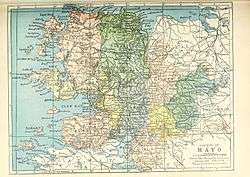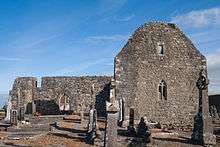Kilmaine
| Kilmaine Cill Mheáin | |
|---|---|
| Village | |
 Kilmaine Location in Ireland | |
| Coordinates: 53°35′00″N 9°07′00″W / 53.5833°N 9.1167°WCoordinates: 53°35′00″N 9°07′00″W / 53.5833°N 9.1167°W | |
| Country | Ireland |
| Province | Connacht |
| County | County Mayo |
| Elevation | 59 m (194 ft) |
| Population (2002) | |
| • Urban | 184 |
| • Rural | 943 |
| Time zone | WET (UTC+0) |
| • Summer (DST) | IST (WEST) (UTC-1) |
| Irish Grid Reference | M260598 |
Kilmaine or Kilmain (Irish: Cill Mheáin) is a barony and village in County Mayo, Ireland.[1]
History
The great cairns and other monuments in the country between Ballinchalla and Cross show it to have been of significance in prehistoric times. Around the time of St. Patrick in the 4th century AD, the tribe known as Conmaicne of Cuil Toladh occupied the baronies of Ross and Kilmaine. The chief of the Cuil Toladh Clan was called O'Talcharain. This tribe did not appear to any significant degree in annals and legends of the time. The country around Kilmaine is distinguished by important Iron Age forts, which mark it as the residence of the local chiefs, if not of principal kings. Some of the major Iron Age/medieval fortresses in the area include Lisnatreanduff in Ballymartin which has three deep ditches, whose sides were once faced with stone. A strong stone wall surrounded the space inside the inner ditch. Similar walls were on the top of the inner sides of the other ditches, and a smaller wall was on the outer edge of the outer ditch. Four entrances, dividing the defences into quadrants, gave access by ground of the natural level. It was probably the greatest fort in Mayo of the earth and stone type, and must have been an impressive building in its time. Rausakeera (Rath Essa Caerach), near Kilmaine, is an earthen fort with a slight ditch and a souterrain inside. This use suggests that it was the inauguration place of former chieftains, adopted by the Bourkes.

When baronies were formed after the time of the Anglo Norman settlements (12th century), it was intended that Kilmaine should consist of the lands of MacWilliam, Sleight Walter, Clan Jonyn, Clan Meyler, and Sleight vic Tibbot and there were many tussles over land divisions in the area. By the 16th century, in the time of Queen Elizabeth 1, Sir Henry Sidney mentions seven lineages, or families, as coming from Mayo. Their relationships held together very much as a clan, having a '° MacDonnell" as chief, and they had great influence in the country. At the close of the sixteenth century they were described as 'only country gentlemen', no longer the leaders of Gallowglass mercenary soldiers. Their principal settlements were in Kilmaine, Carra, Burrishoole, and Tirawley, under the Bourkes, those in Clanmorris, Costello and Gallen being insignificant.
Kilmaine village

"Kilmaine", derived from the Irish language 'Cill Mheán', means The Middle Church – 'Cill' is the word used in the Irish language for a church, and 'meán' is the Irish word for middle. The village is located on the N84 road between Shrule and Ballinrobe. The hinterland is entirely rural, made up of farms and scattered houses. The nearest town is Ballinrobe, and the closest city is Galway, less than twenty kilometres away.
The village of Kilmaine has a population of less than two hundred, while the rural population around Kilmaine is nearly 1000. Kilmaine has only recently begun to see a boost in the building of houses and the development of property in the village. Over the past few years Kilmaine has not received as many immigrants from the new EU member states as other towns and villages in Mayo and this is the main reason the population of the village hasn't grown at the rate that they have. The village of Kilmaine has a post office,a petrol station, two shops four pubs, a Church, School, a Garda (police) station. It also has a Gaelic Athletic Association pitch and a community.
Transport
The village lies on the N84 road that links Galway to Caslebar. A bus service that runs four days a week between Galway and Ballina passes through Kilmaine and also travels through Caslebar.
Sport

The local Gaelic Athletic Association club, Kilmaine GAA, was founded on 9 March 1937. The first competitive game ever played by a Kilmaine team was against Castlegar (Claremorris), in Curran's field. A local boxing club sometimes runs in the community centre.
Kilmaine barony
- Civil parishes in the barony
- Ballinchalla
- Ballinrobe
- Cong
- Kilcommon
- Kilmainebeg
- Kilmainemore
- Kilmolara
- Moorgagagh
- Shrule
- Towns and villages in the barony
- Ballinrobe
- Cong
- Hollymount
- Kilmaine
- Roundfort
- Shrule
- The Neale
See also
| Wikimedia Commons has media related to Kilmaine. |
